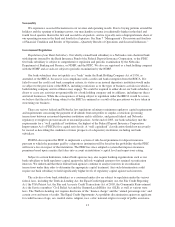Cabela's 2005 Annual Report Download - page 25
Download and view the complete annual report
Please find page 25 of the 2005 Cabela's annual report below. You can navigate through the pages in the report by either clicking on the pages listed below, or by using the keyword search tool below to find specific information within the annual report.Seasonality
We experience seasonal fluctuations in our revenue and operating results. Due to buying patterns around the
holidays and the opening of hunting seasons, our merchandise revenue is traditionally higher in the third and
fourth fiscal quarters than in the first and second fiscal quarters, and we typically earn a disproportionate share of
our operating income in the third and fourth fiscal quarters. See Item 7 “Management’s Discussion and Analysis
of Financial Condition and Results of Operations—Quarterly Results of Operations and Seasonal Influences.”
Government Regulation
Regulation of our Bank Subsidiary. Our wholly-owned bank subsidiary is a Nebraska state-chartered bank
with deposits insured by the Bank Insurance Fund of the Federal Deposit Insurance Corporation, or the FDIC.
Our bank subsidiary is subject to comprehensive regulation and periodic examination by the Nebraska
Department of Banking and Finance, or NDBF, and the FDIC. We also are registered as a bank holding company
with the NDBF and as such are subject to periodic examination by the NDBF.
Our bank subsidiary does not qualify as a “bank” under the Bank Holding Company Act of 1956, as
amended, or the BHCA, because it is in compliance with a credit card bank exemption from the BHCA. If it
failed to meet the credit card bank exemption criteria, its status as an insured depository institution would make
us subject to the provisions of the BHCA, including restrictions as to the types of business activities in which a
bank holding company and its affiliates may engage. We could be required to either divest our bank subsidiary or
divest or cease any activities not permissible for a bank holding company and its affiliates, including our direct
and retail businesses. While the consequences of being subject to regulation under the BHCA would be severe,
we believe that the risk of being subject to the BHCA is minimal as a result of the precautions we have taken in
structuring our business.
There are various federal and Nebraska law regulations relating to minimum regulatory capital requirements
and requirements concerning the payment of dividends from net profits or surplus, restrictions governing
transactions between an insured depository institution and its affiliates, and general federal and Nebraska
regulatory oversight to prevent unsafe or unsound practices. At the end of 2005, our bank subsidiary met the
requirements for a “well capitalized” institution, the highest of the Federal Deposit Insurance Corporation
Improvement Act’s (FDICIA) five capital ratio levels. A “well capitalized” classification should not necessarily
be viewed as describing the condition or future prospects of a depository institution, including our bank
subsidiary.
FDICIA also requires the FDIC to implement a system of risk-based premiums for deposit insurance
pursuant to which the premiums paid by a depository institution will be based on the probability that the FDIC
will incur a loss in respect of that institution. The FDIC has since adopted a system that imposes insurance
premiums based upon a matrix that takes into account an institution’s capital level and supervisory rating.
Subject to certain limitations, federal bank agencies may also require banking organizations such as our
bank subsidiary to hold regulatory capital against the full risk-weighted amount of its retained securitization
interests. We understand that these federal bank agencies continue to analyze interests in securitization
transactions under their rules to determine the appropriate capital treatment. Any such determination could
require our bank subsidiary to hold significantly higher levels of regulatory capital against such interests.
The activities of our bank subsidiary as a consumer lender also are subject to regulation under the various
federal laws, including the Truth-in-Lending Act, the Equal Credit Opportunity Act, the Fair Credit Reporting
Act, the USA Patriot Act, the Fair and Accurate Credit Transactions Act of 2003, the Community Reinvestment
Act, the Service members’ Civil Relief Act and the Gramm-Leach-Bliley Act (GLB), as well as various state
laws. The Truth-in-Lending Act requires disclosure of the “finance charge” and the “annual percentage rate” and
certain costs and terms of credit. The Equal Credit Opportunity Act prohibits discrimination against an applicant
for credit because of age, sex, marital status, religion, race, color, national origin or receipt of public assistance.
13
























